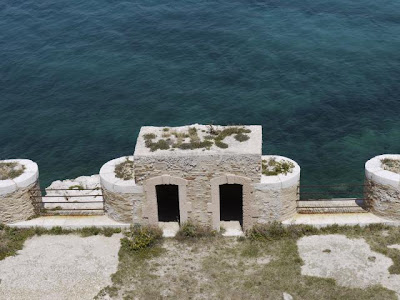Marseille has lots of churches, but Notre Dame de la Garde is the mother of them all. It perches on top of a big hill just south of the old harbor, overlooking the city. It's Marseille's #1 tourist attraction. Getting up there is a long march up steep hills, unless you want to join the old ladies who ride up a ridiculous little toy train from the harbor. Personally I prefer the route through the Jardin de Puget, a small but pretty and relaxing park shielded from the city by many trees, with great views. Marseille is a little short on parks.

The view from the terrace up there is terrific. You get a panorama of the harbor, the little islands out on the sea, and the whole city of Marseille with the mountains as an inland backdrop. No point in Marseille is higher than Notre Dame de la Garde. The only problem is that ugly modern buildings tend to be higher than old buildings, so even though Marseille is an ancient city full of beautiful old buildings (at least downtown), from above it's the modern abominations that stick out. Here's the old harbor in the foreground, with the modern harbor in the background:
The church is nice enough outside. But inside it's one of the most beautiful, perhaps
the most beautiful, church I have ever seen. So many churches are gloomy, echoing caverns, built to intimidate, full of imperial-looking marble statues keeping watch over the visitors; but this church is bright and cheerful with white, red, and gold.
There are some pretty weird details inside. It's a catholic basilica and catholics have this tendency towards superstition and gruesome souvenirs like mummified bones of saints, and I believe there are enough Certified Splinters of the True Cross to build a dozen crosses. But catholics have this peculiar nonaggression pact with objective truth so that's ok. There are various beautifully crafted relic containers scattered about this church, and little boat models are suspended from the ceiling. Not just ancient ones but also fairly modern ship models. Apparently that's a form of rain dance: you sacrifice a ship to the church to ward off misfortune, just like a caveman sacrificing a chicken to whatever vengeful gods they had in those days.
Plus ça change, plus c'est la même chose.
While I am writing this I am backing up a notebook hard disk that has started to make worrisome noises; maybe I should have donated a disk in time? I can picture the stuff they'd hang from the ceiling if the sacrifice arrangements were still open for business: hard disks, iPhones, car clutches, Gawker accounts, mortgage-backed securities...
The odd thing is that many people here are taking this seriously. In northern Europe, churches are usually tourist attractions or event locations or whatever pays for the upkeep, but the religious services for which they were built attract just a handful of old people. Not so here. A mass can actually fill up a church, and people come to pray.
Notre Dame de la Garde, like a pretty large percentage of all Christian churches, is dedicated to Mary, mother of God. There are way more churches dedicated to her (
notre dame, our lady), where the faithful pray to her, than to Jesus and God himself, the other main characters in the Christian pantheon. In my book that makes her a goddess. They've also got hundreds of saints specializing in various vocations such as protecting travelers, available for praying to; they fill the role of demi-gods in older religions except that they are all born Muggles. But Christianity's founding myth is, of course, anathema to such interpretations because they've made up their own myths over the past two millennia. All this is very confusing. I just go there to take pictures, and take refuge in the fact that blasphemous questions are no longer answered with torture and death. What remains is the beauty of Europe's cathedrals.
There's also a crypt under the church, but it's quite plain and poorly ventilated, and gets hot and stuffy in the summer. Not much to see there. If you want to see a spectacular crypt, go to Siena.
















